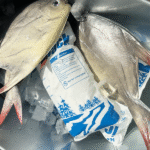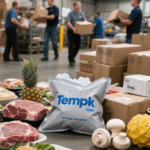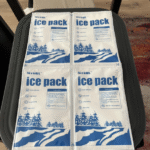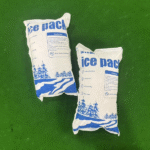Need to hold –78 °C cold packs for a 3‑day biotech run? A Dry Ice Keeper—purpose‑built storage canister—cuts sublimation losses by up to 55 %. This playbook compares designs, loading math, and 2025 safety codes so you never run warm.
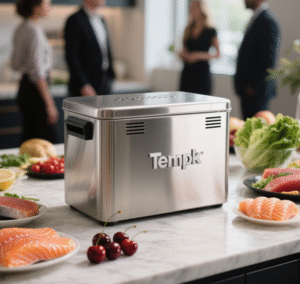
This Guide Explains
-
Which Dry Ice Keeper design slows sublimation best?
-
Exact CO₂ weight vs. hold‑time formulas.
-
2025 OSHA & IATA ventilation rules.
-
User‑tested tricks to reuse keepers and slash costs.
What Makes a Dry Ice Keeper Different?
Key upgrades over a basic cooler:
-
Vacuum‑insulated steel shell—< 3 W/m·K thermal conductivity.
-
Pressure‑relief valve calibrated at 25 psi.
-
Replaceable CO₂ adsorbent pad to capture vapor spikes.
Mini‑Study: A pharma hub switched from Styrofoam boxes to 18 L stainless Dry Ice Keepers and cut weekly dry ice orders from 680 lb to 310 lb—saving $415/week on consumables.
Keeper Types Compared
| Model | Capacity | Wall Build | Avg. 24 h Loss | Ideal Use |
|---|---|---|---|---|
| Compact 5 L | 11 lb CO₂ | Dual SS + vacuum | 18 % | Mobile vaccine teams |
| Mid 15 L | 33 lb CO₂ | SS + PU foam + foil | 14 % | Seafood export depots |
| Max 40 L | 88 lb CO₂ | SS + aerogel panel | 9 % | Lab bulk storage |
How Much Dry Ice Should You Load?
Rule of thumb: Storage days × 8 lb = CO₂ needed per cubic foot of keeper volume.
Quick Formula
Dry Ice (lb) = Keeper Volume (ft³) × Hold Days × 8
Example: 1.2 ft³ keeper × 4 days × 8 = 38 lb.
Warning: Exceeding 90 % fill blocks gas circulation and over‑pressurizes valves.
Loading Steps
-
Pre‑chill keeper for 30 min with sacrificial pellets.
-
Fill to 70 % with dense blocks—stack loosely.
-
Top off with pellets to occupy gaps (promotes uniform sublimation).
-
Close lid, verify valve arrow aligns with vent groove.
2025 Safety & Compliance Snapshot
-
OSHA Indoor CO₂ Ceiling: 4,000 ppm TWA (was 5,000 ppm). Use keepers in rooms ≥ 6 ACH.
-
IATA DGR Addendum: Dry Ice Keepers classified as “UN 1845, Packing Instruction 955B” if valve rated ≥ 25 psi.
-
EU Ecodesign Directive: Requires PFAS‑free gaskets in cold‑chain containers by Oct 2025.
Ventilation Checklist
| Room Size | Keeper Count Max | CO₂ Sensor Needed? | Action if >4,000 ppm |
|---|---|---|---|
| 100 ft² | 1 mid | Optional | Open door/windows |
| 300 ft² | 3 mid | Yes | Engage exhaust fan |
| 600 ft² | 2 max | Yes | Evacuate room |
Hacking Hold‑Time: Field‑Tested Tips
Swap‑Out CO₂ Pads
-
Replace adsorbent every 200 lb of dry ice to keep flow channels clear.
Reflective Wrap
-
Wrapping keeper in silverized bubble film adds ~6 h cold life on pallet shipments.
Smart Cap Logger
-
BLE lid records internal temp & pressure; sends alert when ≥ 18 psi.
Real‑World Win: A genomics courier used smart caps and slashed lost‑sample claims from 7 % to < 1 % in one quarter.
FAQ {#faq}
Is a Dry Ice Keeper airline‑approved?
Yes, if under 50 kg gross and valve stamped “UN 1845‑25 psi.”
Can I store dry ice in a walk‑in freezer instead?
It slows sublimation only 10 %. Keepers extend life up to 55 %.
How do I clean the keeper?
Use 70 % IPA wipes; avoid hot water—rapid temp swings can warp seals.
Key Takeaways
-
Load 8 lb CO₂ per ft³ per day for reliable hold‑times.
-
Vacuum‑insulated steel keepers beat coolers, cutting losses to single digits.
-
Stay ahead of 2025 OSHA & IATA updates—valve rating and indoor CO₂ caps.
What to Do Next
-
Audit current dry ice consumption vs keeper size.
-
Book a Tempk Keeper demo to trial vacuum models.
-
Install CO₂ sensors before OSHA fines kick in Q3 2025.
About Tempk
Tempk engineers next‑gen Dry Ice Keepers and IoT monitoring tools that keep payloads at –78 °C longer, with 40 % less CO₂ waste. Ship smarter—talk to our cold‑chain team today.

















